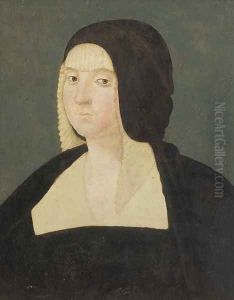Giovanni Antonio Boltraffo Paintings
Giovanni Antonio Boltraffio, also spelled Boltraffo, was an Italian painter of the High Renaissance who was born in Milan between 1466 and 1467. He was a distinguished artist who worked primarily in Milan and was deeply influenced by Leonardo da Vinci, with whom he is said to have studied. Boltraffio's work is often characterized by its fine detail, delicate modeling, and the serene and contemplative nature of its subjects, which reflect the influence of his famous mentor.
Boltraffio came from an aristocratic family, which afforded him a high-quality education. This background also allowed him to move in elevated social circles and receive important commissions. His training under Leonardo began around 1491, and during this time, he absorbed many aspects of Leonardo's style, including his sfumato technique and the psychological depth of character portrayal. Boltraffio's own talents and Leonardo's influence combined to create a body of work that was both technically accomplished and emotionally resonant.
Throughout his career, Boltraffio remained in Milan, working on various commissions for altarpieces, religious works, and portraits. Some of his notable works include 'The Madonna Litta', which is sometimes attributed to Leonardo himself, and 'The Madonna and Child', which showcases Boltraffio's skill in portraying tender human relationships with a grace reminiscent of his master's work. His portraits, such as the 'Portrait of a Young Man', demonstrate a keen attention to detail and an ability to capture the sitter's personality.
Boltraffio's artistic output was not limited to painting. He also provided designs for stained glass windows and worked on frescoes, though much of this work has not survived or has been attributed to other artists of the same period. His influence extended to his contemporaries and pupils, who carried forward the stylistic elements that he honed under Leonardo's tutelage.
Giovanni Antonio Boltraffio's life was cut short when he died prematurely in 1516. Despite his early death, his legacy lived on through his masterpieces and his influence on other artists. His work continues to be studied and admired for its embodiment of High Renaissance ideals and its testament to the close association between teacher and pupil in the development of Renaissance art.
